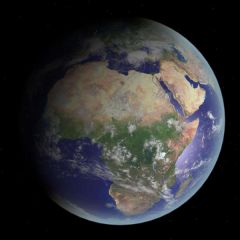Earth
Earth is the third planet from the Sun and is the only body known to have life. It is one of the four 'rocky' planets, the others are Mercury, Venus, and Mars. The Moon is the only natural satellite orbiting the earth.
The Earth is close to an oblate spheroid, but, in Orbiter it's modeled as a sphere, its mean diameter is 6371.01 km, but gravitational calculations include the J coefficients given in the table to the right. The sidereal day is 86164.092 seconds, the obliquity is 23.439291°.
Orbital characteristics
Earth is the third planet from the Sun, after Mercury and Venus, with a semimajor axis in Orbiter of about 1.49598×1011 km, and an orbital eccentricity of about 0.0167, and an inclination of 0.00005° (0.00000087 radian).
Physical characteristics
The Earth is modeled in Orbiter as a sphere 6371.01 km in radius with a mass of about 5.974×1024 kg. The Sidereal rotation period is just under 24 hours. At the surface the acceleration due to gravity is 9.78 m/s2</sup, and the Escape velocity|escape velocity]] is 11.186 km/s.
Geological features
In Orbiter 2016, Earth is modeled as a sphere with elevations approximating the elevations on the real Earth, including sea level. Included in the stock version are files for Antartic Stations, Cities, Impact Features Islands, Mountains and volcanos, Tracking Stations, and some miscellaneous features. Files are located in your Orbiter\Config\Earth\Marker directory.
Natural satellites
Spaceports
The stock Orbiter includes 35 bases, some of which include details such as runways, landing pads, buildings, etc, some only include a marker to depict its location.
See Listing of Earth spaceports in Orbiter2016
See also
- Spaceport, a listing of spaceports on the real Earth used to launch rockets and spacecraft.
- Earth spaceports in Orbiter2016
- Addons for Earth
- Earth at Wikipedia
External links
Earth at Wikipedia
| edit The Solar System | |
|---|---|
| Central star |
Sun (Sol) |
| Planets |
Mercury - Venus - Earth - Mars - Jupiter - Saturn - Uranus - Neptune |
| Natural satellites |
Moon - Phobos - Deimos - Io - Europa - Ganymede - Titan - more... |
| Add-ons |
Planets - Dwarf Planets - Small objects - Natural satellites - Alternative star systems |
 | This article, about a planet, is a stub. You can help Orbiterwiki by expanding it.
|
